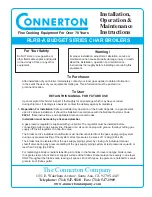
General Information
9
Mechanical Room
During the early stages of designing a new home, we recommend that proper consideration be given to constructing a
separate mechanical room dedicated to the gas- or oil-fired heating equipment and domestic hot water storage tank(s).
The boiler must be located in a heated indoor area, near a floor drain, and as close as possible to a wall. Whenever possible,
install the boiler near an outside wall so that it is easy to duct the venting system to the boiler.
Locate the boiler on a wall capable of supporting the weight of the boiler filled with water (see section entitled “Technical
Data” on page 54 for information required for total boiler weight calculation). Ensure that the boiler location does not
interfere with the proper circulation of combustion and ventilation air of other fuel burning equipment within the mechanical
room (if applicable).
The maximum room temperature of the mechanical room where the boiler is located must not exceed 104ºF / 40ºC.
Installation area conditions
Ensure ambient temperatures are
higher than 32°F / 0°C and lower
than 104°F / 40°C.
Prevent the air from becoming
contaminated by halogenated
hydrocarbons (e.g. as contained in
paint solvents or cleaning fluids) and
excessive dust (e.g. through grinding
or polishing work). Combustion air for
the heating process, and ventilation
of the boiler room must be free of
corrosive contaminants. To that end,
any boiler must be installed in an area
that has no chemical exposure. The
list to the right indicates the main,
currently known sources.
Avoid continuously high levels of
humidity (e.g. through frequent
drying of laundry).
Never close existing ventilation
openings.
Sources of combustion and ventilation
air contaminants
Areas likely to contain contaminants:
New building construction
Swimming pools
Remodelling areas, hobby rooms
Garages with workshops
Furniture refinishing areas
Dry cleaning/laundry areas and
establishments
Auto body shops
Refrigeration repair shops
Metal fabrication plants
Plastic manufacturing plants
Photo processing plants
Beauty salons
Products containing contaminants:
Chlorine-type bleaches, detergents
and cleaning solvents found in
household laundry rooms
Paint and varnish removers
Hydrochloric acid, muriatic acid
Chlorine-based swimming pool
chemicals
Spray cans containing
chlorofluorocarbons
Chlorinated waxes and cleaners
Cements and glues
Refrigerant leaks
Calcium chloride used for thawing
Sodium chloride used for water
softening salt
Permanent wave solutions
Adhesives used to fasten building
products and other similar items
Antistatic fabric softeners used in
clothes dryers
Boiler operation in marine environments
(damp, salty coastal areas)
The service life of the boiler’s exposed
metallic surfaces, such as the casing
and fan housing, is directly influenced
by proximity to damp and salty marine
environments. In such areas, higher
concentration levels of chlorides from
sea spray, coupled with relative
humidity, can lead to degradation of
the exposed metallic surfaces
mentioned above. Therefore, it is
imperative that boilers installed in such
environments
not
be installed using
direct vent systems which draw
outdoor air for combustion. Such
boilers must be installed using room air
dependent vent systems; i.e. using
room air for combustion. The indoor air
will have a much lower relative
humidity and, hence, potential
corrosion will be minimized.
5
3
6
9
2
9
7
v
1
.6
Incorrect ambient conditions can lead
to damage to the heating system and
put safe operation at risk.
WARNING
If you notice fire coming from the
appliance, call the fire department
immediately! Do not attempt to
extinguish the fire unless qualified to
do so.
WARNING
Fire causes a risk of burns and
explosion!
H
H
H
H
Shut down the boiler
H
H
H
H
Close fuel shut-off valves
H
H
H
H
Use a tested fire extinguisher,
class ABC.
WARNING
IMPORTANT
Содержание Vitodens 200-W 19 WB2B Series
Страница 61: ...61 5369 297 v1 6...
Страница 62: ...62 5369 297 v1 6...
Страница 63: ...63 5369 297 v1 6...










































